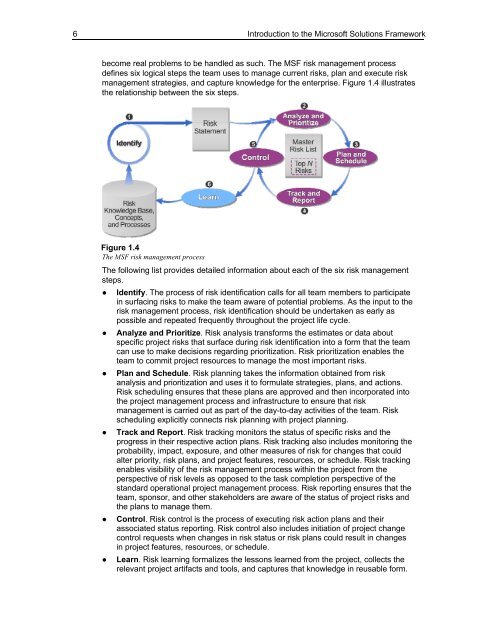Solution Guide for Migrating Oracle on UNIX to SQL Server - Willy .Net
Solution Guide for Migrating Oracle on UNIX to SQL Server - Willy .Net
Solution Guide for Migrating Oracle on UNIX to SQL Server - Willy .Net
- No tags were found...
Create successful ePaper yourself
Turn your PDF publications into a flip-book with our unique Google optimized e-Paper software.
6Introducti<strong>on</strong> <strong>to</strong> the Microsoft <str<strong>on</strong>g>Soluti<strong>on</strong></str<strong>on</strong>g>s Frameworkbecome real problems <strong>to</strong> be handled as such. The MSF risk management processdefines six logical steps the team uses <strong>to</strong> manage current risks, plan and execute riskmanagement strategies, and capture knowledge <str<strong>on</strong>g>for</str<strong>on</strong>g> the enterprise. Figure 1.4 illustratesthe relati<strong>on</strong>ship between the six steps.Figure 1.4The MSF risk management processThe following list provides detailed in<str<strong>on</strong>g>for</str<strong>on</strong>g>mati<strong>on</strong> about each of the six risk managementsteps.● Identify. The process of risk identificati<strong>on</strong> calls <str<strong>on</strong>g>for</str<strong>on</strong>g> all team members <strong>to</strong> participatein surfacing risks <strong>to</strong> make the team aware of potential problems. As the input <strong>to</strong> therisk management process, risk identificati<strong>on</strong> should be undertaken as early aspossible and repeated frequently throughout the project life cycle.● Analyze and Prioritize. Risk analysis trans<str<strong>on</strong>g>for</str<strong>on</strong>g>ms the estimates or data aboutspecific project risks that surface during risk identificati<strong>on</strong> in<strong>to</strong> a <str<strong>on</strong>g>for</str<strong>on</strong>g>m that the teamcan use <strong>to</strong> make decisi<strong>on</strong>s regarding prioritizati<strong>on</strong>. Risk prioritizati<strong>on</strong> enables theteam <strong>to</strong> commit project resources <strong>to</strong> manage the most important risks.● Plan and Schedule. Risk planning takes the in<str<strong>on</strong>g>for</str<strong>on</strong>g>mati<strong>on</strong> obtained from riskanalysis and prioritizati<strong>on</strong> and uses it <strong>to</strong> <str<strong>on</strong>g>for</str<strong>on</strong>g>mulate strategies, plans, and acti<strong>on</strong>s.Risk scheduling ensures that these plans are approved and then incorporated in<strong>to</strong>the project management process and infrastructure <strong>to</strong> ensure that riskmanagement is carried out as part of the day-<strong>to</strong>-day activities of the team. Riskscheduling explicitly c<strong>on</strong>nects risk planning with project planning.● Track and Report. Risk tracking m<strong>on</strong>i<strong>to</strong>rs the status of specific risks and theprogress in their respective acti<strong>on</strong> plans. Risk tracking also includes m<strong>on</strong>i<strong>to</strong>ring theprobability, impact, exposure, and other measures of risk <str<strong>on</strong>g>for</str<strong>on</strong>g> changes that couldalter priority, risk plans, and project features, resources, or schedule. Risk trackingenables visibility of the risk management process within the project from theperspective of risk levels as opposed <strong>to</strong> the task completi<strong>on</strong> perspective of thestandard operati<strong>on</strong>al project management process. Risk reporting ensures that theteam, sp<strong>on</strong>sor, and other stakeholders are aware of the status of project risks andthe plans <strong>to</strong> manage them.● C<strong>on</strong>trol. Risk c<strong>on</strong>trol is the process of executing risk acti<strong>on</strong> plans and theirassociated status reporting. Risk c<strong>on</strong>trol also includes initiati<strong>on</strong> of project changec<strong>on</strong>trol requests when changes in risk status or risk plans could result in changesin project features, resources, or schedule.● Learn. Risk learning <str<strong>on</strong>g>for</str<strong>on</strong>g>malizes the less<strong>on</strong>s learned from the project, collects therelevant project artifacts and <strong>to</strong>ols, and captures that knowledge in reusable <str<strong>on</strong>g>for</str<strong>on</strong>g>m.
















